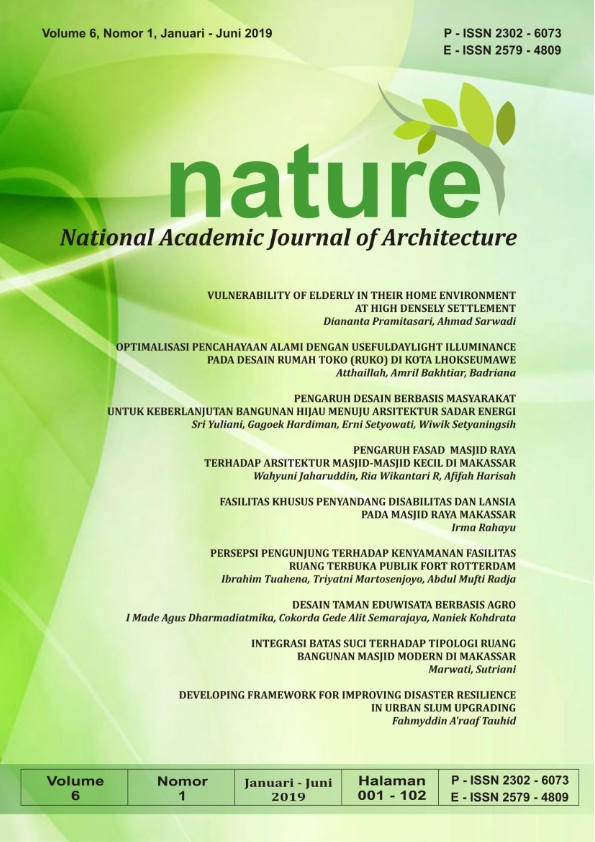PENGARUH DESAIN BERBASIS MASYARAKAT UNTUK KEBERLANJUTAN BANGUNAN HIJAU MENUJU ARSITEKTUR SADAR ENERGI
Abstract
Abstrak_Konsep arsitektur sadar energi mempertimbangkan efisiensi dan konservasi sumber daya alam dalam proses merancang, diantaranya dengan implementasi bangunan hijau. Kinerja desain pada bangunan hijau dipengaruhi oleh konsistensi pelaku utama pembangunan yakni pemerintah, perencana, perancang/arsitek, dan masyarakat pengguna. Komitmen mempertahankan desain hijau dapat berjalan berkesinambungan manakala terbentuk pola hubungan peran dan desain yang saling mendukung. Penelitian bertujuan mengidentifikasi hubungan desain dengan peran masyarakat untuk keberlanjutan bangunan hijau. Lokasi penelitian merupakan representasi karakter kota di Indonesia, yakni Kota Surakarta. Penelitian menggunakan metode kualitatif dengan pendekatan induktif melalui survei lapangan. Pengumpulan data diperoleh melalui pengamatan lapangan, wawancara dan kuisioner dengan teknik purposive sampling. Hasil penelitian menunjukkan adanya hubungan antara peran masyarakat dengan keberlanjutan desain bangunan hijau, dimana terdapat respon yang berbeda pada desain yang mengakomodasi peran masyarakat dan adanya kontribusi yang berbeda dari tingkat ekonomi masyarakat untuk mendukung keberlanjutan desain hijau.
Kata kunci : Desain; Peran Masyarakat; Keberlanjutan; Bangunan Hijau
Abstract_The concept of energy-conscious architecture considers the efficiency and conservation of natural resources in the design process, including the implementation of green buildings. Design performance in green buildings is influenced by the consistency of the main actors of development, namely the government, planners, designers/architects, and the user community. Commitment to maintaining a green design can run continuously when a role and design relationship pattern is formed that supports each other. The research aimed to identify design relationships with the role of the community for the sustainability of green buildings. The research location was a representation of the character of cities in Indonesia, namely the City of Surakarta. The study used qualitative methods with an inductive approach through field surveys. Data collection was obtained through field observations, interviews and questionnaires with purposive sampling technique. The results of the research indicated that there was a relationship between the role of the community and the sustainability of green building design, where there were different responses to the design that accommodate the role of the community and the existence of different contributions from the economic level of the community to support the sustainability of the green design.
Keywords: Design in Architectu;, Community Participator; Sustainability; Green Building
Downloads
References
Abbass, O. A., Sailor, D. J., & Gall, E. T. (2018). Ozone removal efficiency and surface analysis of green and white roof HVAC filters. Building and Environment, 136(March), 118–127. https://doi.org/10.1016/j.buildenv.2018.03.042
Creswell, J. W. (2014). Research Design: Qualitative, Quantitative, and Mixed Method. Research design Qualitative quantitative and mixed methods approaches. https://doi.org/10.1007/s13398-014-0173-7.2
Frueh, S. (2016). Green Roof News. In International Green roof Association (2016th ed., pp. 1–35). International Green Roof Association (IGRA). Retrieved from www.igra-world.com
Groat, L. N., & Wang, D. (2013). Architectural research methods.The Routledge Companion for Architecture Design and Practice: Established and Emerging Trends. https://doi.org/10.1093/ecco-jcc/jjy097
Heinz, Frick; Suskiyatno, B. (1998). Dasar-dasar Eko-arsitektur. Semarang: Penerbit Kanisius dan Soegijapranata University Press.
Imran, H. M., Kala, J., Ng, A. W. M., & Muthukumaran, S. (2018). Effectiveness of green and cool roofs in mitigating urban heat island effects during a heatwave event in the city of Melbourne in southeast Australia. Journal of Cleaner Production, 197, 393–405. https://doi.org/10.1016/j.jclepro.2018.06.179
Jimmy Priatman. (2002). “Energy-Efficient Architecture” Paradigma Dan Manifestasi Arsitektur Hijau. DIMENSI (Jurnal Teknik Arsitektur), 30(2), 167–175. Retrieved from http://puslit2.petra.ac.id/ejournal/index.php/ars/article/view/15778
Moskow, K. (2008). Sustainable Facilities - Green Design, Construction and Operations. New York: Mc Graw Hill.
Rademacher, A. (2017). Building Green : Environmental Architects and the Struggle for Sustainability in Mumbai.
Sharma, M. (2018). Development of a ‘Green building sustainability model’ for Green buildings in India. Journal of Cleaner Production, 190, 538–551. https://doi.org/10.1016/j.jclepro.2018.04.154
Teotónio, I., Silva, C. M., & Cruz, C. O. (2018). Eco-solutions for urban environments regeneration: The economic value of green roofs. Journal of Cleaner Production, 199, 121–135. https://doi.org/10.1016/j.jclepro.2018.07.084
Tricarico, L. (2017). Community action : value or instrument ? An ethics and planning critical review An Ethics and Planning Critical Review, 7955(September). https://doi.org/10.3846/20297955.2017.1355278
Xie, G., Lundholm, J. T., & Scott MacIvor, J. (2018). Phylogenetic diversity and plant trait composition predict multiple ecosystem functions in green roofs. Science of the Total Environment, 628–629, 1017–1026. https://doi.org/10.1016/j.scitotenv.2018.02.093
Yuliani, S., & Setyaningsih, W. (2018). The community role in green area sustainability as a model of energy- efficient buildings in the humid tropical region. In IOP Conference Series: Earth and Environmental Science. IOP Publishing. https://doi.org/10.1088/1755-1315/213/1/012010
Copyright (c) 2019 Sri Yuliani, Gagoek Hardiman, Erni Setyowati, Wiwik Setyaningsih

This work is licensed under a Creative Commons Attribution-ShareAlike 4.0 International License.
By submitting your manuscript to our journal, you are following Copyright and License











